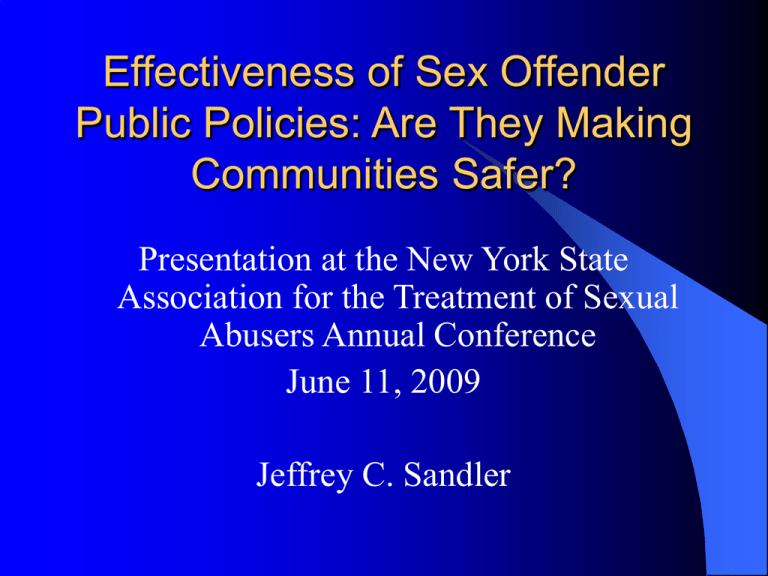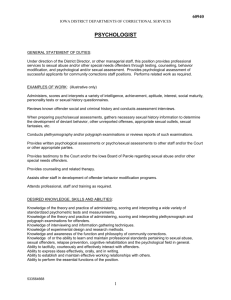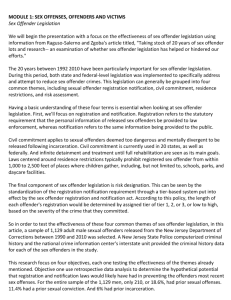
Effectiveness of Sex Offender
Public Policies: Are They Making
Communities Safer?
Presentation at the New York State
Association for the Treatment of Sexual
Abusers Annual Conference
June 11, 2009
Jeffrey C. Sandler
Purpose: Review the Public Safety
Research Literature
Registration
and Community Notification
– SORNA (Adam Walsh)
– Community members
– Impact on offending
Residency
Civil
Restrictions
Management
Part 1:
Sex Offender Registration and
Community Notification
Legislative History
Jacob Wetterling Crimes Against Children
and Sexually Violent Offender Registration
Act (1994)
Megan’s Law (1996)
Pam Lychner Act (1996)
New York State’s Sex Offender Registration
Act (SORA; 1996)
Campus Sex Crimes Prevention Act (2000)
Adam Walsh Child Protection and Safety Act
(2006) - SORNA
Adam Walsh Act
Signed by President Bush July 27, 2006
Amends previously enacted sex offender
policies
States have until July 26, 2010 to fully
enact or risk losing 10% of Byrne
funding
Adam Walsh Act: SORNA
Divides sex offenders into three tiers
based solely on crime of conviction
– Tier 1: Misdemeanor sexual offenses
– Tier 2: Less severe felony sexual offenses
(e.g., use of minor in sexual performance,
criminal sexual act, production or distribution
of child pornography)
– Tier 3: More severe felony sexual offenses
(e.g., persistent sexual abuse, predatory
sexual assault, aggravated sexual abuse)
Adam Walsh Act: SORNA
Tier level determines length of registration
and extent of community notification
– Tier 1 = 15 years
– Tier 2 = 25 years
– Tier 3 = life
Expands in person verification requirements
and enhances public access to information
Research on SORNA
The Adam Walsh Act: A False Sense of
Security or an Effective Public Policy?
Naomi J. Freeman
Jeffrey C. Sandler
Article is currently in press
(Criminal Justice Policy Review)
Research of Sexual Recidivism
Not all sex offenders pose the same risk:
Extrafamilial child molesters who offended
against male victims most likely to reoffend
Research has identified many factors that
are related to an increase in risk of sexual
recidivism
(Hanson & Bussiere, 1998; Harris & Hanson, 2004)
Sex Offender Risk Factors
(non-exhaustive)
Male victims
Deviant sexual interest
Antisocial personality traits
General self-regulation problems
Sexual preoccupation
Being young
Prior sex offenses
Prior criminal history
– Engagement in a diversity of crimes
Goal of the Study
Empirically examine the ability of SORNA
three-tier system to predict sexual
recidivism
Investigate whether other well-established
and easily obtainable risk factors (whether
alone or in combination) might increase
predictive ability of SORNA
Method: Participants
17,165 registered sex offenders in New York
State (92.2% of all registered sex offenders)
– Probation supervision (43.2%)
– Parole supervision (36.6%)
– Not under supervision (20.2%)
63.6% White; 30.6% Black
Average at 32.88 (14 – 91 years old) at time of
instant offense arrest
Method: Dependent Variables
Dichotomous
measures of:
– Re-arrest for any non-sexual offense
– Re-arrest for any registerable sexual
offense
Method: SORNA Tier Level
Categorical
variable:
– Tier 1, 2, or 3
Compared New
York State Penal
Codes to SORNA
guidelines
9000
8000
7000
6000
5000
4000
3000
2000
1000
0
Tier 1
Tier 2
Tier 3
Method: Other Risk Predictors
Offender Demographics
– Supervision Type
– Age at Time of Release
– County of Residence
Rural
Urban
Midsize
Method: Other Risk Predictors
Prior Criminal History
–
–
–
–
–
–
# Prior Violent Felony Offense Arrests
# Prior Registerable Sexual Offense Arrests
# Prior Drug Offense Arrests
# Different Types of Crime in History
# Prior Incarceration Terms Served
# Prior Supervision Violations
Results:
Direct Test of SORNA
Rates of sexual re-arrest:
– Tier 1 (8.1%)
– Tier 2 (6.1%)
– Tier 3 (7.5%)
SORNA tier level was not significantly
correlated to sexual (r = .00) or non-sexual
re-arrest (r = .02)
Correlations between Predictor
Variables and Non-Sexual and Sexual
Re-Arrest
Non-Sexual
Sexual
Re-Arrest
Re-Arrest
SORNA Tier Level
.02
.00
Supervision Type
.13*
.07*
Prior VFO Offense Arrests
.20*
.10*
Prior Drug Offense Arrests
.17*
.03*
Prior Registerable Sex Offense Arrests
.05*
.10*
Variety of Offenses
.42*
.16*
Prior Supervision Violations
.17*
.05*
Prior Incarceration Terms
.33*
.13*
Offender Race
-.20*
-.06*
Offender Age at Release
-.28*
-.07*
Results:
Time to Re-Arrest
Offenders followed for 8 years
– M = 4.6 years for sexual offense model
– M = 3.6 years for non-sexual offense model
Tier 1 (lowest risk) re-arrested for sexual
offenses more quickly than both Tier 2
(moderate risk) and Tier 3 (high risk)
– 104% and 90%, respectively
Sexual Offense Re-Arrest by Tier
Level
Non-Sexual Offense Re-Arrest
by Tier Level
Discussion
Results cast doubts on ability of SORNA
provisions to increase public safety:
– SORNA unable to predict who will re-offend
– Crime of conviction not accurate indication of
offense (e.g., plea to lesser offense)
Almost any well-established risk factor
would be a better predictor than tier level
(i.e., crime of conviction)
Enactment of SORNA may give
communities false sense of security
Discussion (cont.)
Recent analysis (Justice Policy Institute,
2008) indicates cost of implementing
SORNA may outweigh costs of losing
10% of Byrne funding:
– Estimated cost for New York State to
implement SORNA: $31,300,000
– 10% of New York State’s Byrne funding in
2006: $1,100,000
Broader question: The ability of any
registration and notification laws to
increase public safety
Research on Community Members
and Registration and Notification
Phillips (1998):
– More than 60% of community members
believed registration and notification encouraged
sex offenders to behave better
– Over 50% of respondents:
No change in leaving children with babysitter or
unsupervised
No less likely to go out alone
No change in level of community involvement
Research on Community Members
and Registration and Notification
Anderson & Sample (2009):
– Almost 90% of respondents aware of the registry
– Only 35% had accessed it
– Over 60% of community members report taking
no preventative measures
– The most common preventative measure taken
was to pass the information along
Children
Neighbors
Research on Community Members
and Registration and Notification
Kernsmith, Comartin, Craun, & Kernsmith
(2009)
– Over 94% of respondents aware of the registry
– Only 37% had accessed it: Families with young
children most likely (59%)
– Sex offenders found to live in 99% of zip codes
Only 27% of respondents believed an offender lived
their community
Of those who had accessed the registry, 51% believed
an offender lived in their community
Research on the Impact of Sex Offender
Registration and Notification:
Evaluations using Offenders
Schram & Milloy (1995): No significant
difference in re-arrest rates between registered
(n = 90) and unregistered (n = 90) sex
offenders in Washington State
Freeman (in press): New York State sex
offenders subject to notification were rearrested more quickly and at a higher rate than
those not subject to notification requirements
Research on the Impact of Sex Offender
Registration and Notification:
Evaluations using Crime Rates
Barnoski (2005):
– Findings:
Rates of sexual felony recidivism dropped after 1990
passage of registration law
Rates of sexual felony and violent felony recidivism
dropped after 1997 amendment of the notification law
– Study limitations:
Like the previous two studies, only looked at recidivisms
Only examined rates through percentage comparisons
and binary logistic regression, so ignored natural changes
in the crime rate
Research on the Impact of Sex Offender
Registration and Notification:
Evaluations using Crime Rates (cont.)
● Walker, Maddan, Vásquez, VanHouten, &
Ervin-McCarthy (2005):
– Findings:
Six states experienced no change in rape arrest rates
Three states experienced a drop in rape arrest rates
One state experienced an increase in rape arrest rate
– Study Limitations
Used UCR data: Could not separately model
recidivisms, first time offenses, or different sex offenses
Modeled no non-sexual offense series for comparison
Research on the Impact of Sex Offender
Registration and Notification:
Evaluations using Crime Rates (cont.)
Zgoba, Witt, Dalessandro, & Veysey (2008)
– Findings:
Statewide sexual offense rates steadily decreased from
1985 to 2005
No consistent effect of Megan’s Law at county level
Costs an average of about $265,000 per county per year
to maintain the registry (mostly for staff)
Limited effect of Megan’s Law may not justify expense
– Study Limitations:
Used UCR data: Could not separately model
recidivisms, first time offenses, or different sex offenses
Using a New York State Sample
Does a Watched Pot Boil? A Time-Series
Analysis of New York State’s Sex Offender
Registration and Notification Law
Jeffrey C. Sandler
Naomi J. Freeman
Kelly M. Socia
Article published in:
Psychology, Public Policy, and Law (2008), 14, 284-302
Goals of the Study
● An empirical time-series analysis of the
impact of New York State’s 1996 Sex
Offender Registration Act (SORA)
● An attempt to understand how SORA’s
enactment influenced arrests rates
● An attempt to investigate how different
types of offending were impacted
Data
● Two hundred and fifty-two months (21
years) of statewide arrest data from 1986
[10 years before SORA] to 2006 [11 years
afterward]
● Aggregated to the state level
● Included every sexual offense arrest [and
therefore every sex offender arrested]
during that time
– Over 170,000 sexual offenses
– Over 160,000 different sex offenders
Series Modeled
● Test (9)
– Registerable sex offenses (RSOs)
• Total
• Recidivisms
• First time sex offenses
– Rapes
• Total
• Recidivisms
• First time sex offenses
– Child molestations
• Total
• Recidivisms
• First time sex offenses
● Comparison (8)
– Within group (sex offenders)
• Assaults
• Robberies
• Burglaries
• Larcenies
– Outside group (statewide)
• Assaults
• Robberies
• Burglaries
• Larcenies
Test Series Example:
RSO arrest counts
Results:
Basic offending statistics
● Most sexual offenses committed by first time
sex offenders (i.e., were not sexual recidivisms)
– Total RSOs: 95.88%
– Rapes: 95.94%
– Child molestations: 94.12%
Results:
Interrupted ARIMA
● All test and comparison series were found
to be ARIMA (0,1,1)(0,1,1)12 models
● Test series: No significant change (increase
or decrease) in the number of monthly
arrests in any of the sexual offense series
Discussion
● Limitations
– Re-arrest only a proxy measure for offending
– Study does not examine differential effects by:
• Geographic region
• Offender risk level
● Conclusions
– No evidence that registration and community
notification laws impact rates of sexual offending
– Resources may be better spent on other, evidencebased strategies to reduce sexual offending (e.g.,
treatment programs)
Summary:
Registration and Notification
Little to no research to support their ability to
reduce first time or repeat sexual offending
No research to support their ability to reduce
child molestations
Expensive to set up, maintain, and enforce
Community members are in favor of the
registries, but do not use them often
Selected References: Registration and Notification
Anderson, A. L., & Sample, L. L. (2008). Public awareness and action resulting
from sex offender community notification laws. Criminal Justice Policy
Review, 19, 371-396.
Barnoski, R. (2005). Sex offender sentencing in Washington State: Has community
notification reduced recidivism? Olympia, WA: Washington Institute for
Public Policy.
Freeman, N. J. (in press). The public safety impact of community notification
laws: Re-Arrest of convicted sex offenders. Crime & Delinquency. Available
though OnlineFirst at http://cad.sagepub.com/pap.dtl
Freeman, N. J., & Sandler, J. C. (in press). The Adam Walsh Act: A false sense of
security or an effective public policy initiative? Criminal Justice Policy
Review.
Justice Policy Institute. (2008). What will it cost to comply with the Sex Offender
Registration and Notification Act. Washington, DC: Author.
Phillips, D. M. (1998). Community notification as viewed by Washington’s
citizens. Olympia, WA: Washington State Institute for Public Policy.
Sandler, J. C., Freeman, N. J., & Socia, K. M. (2008). Does a watched pot boil? A
time-series analysis of New York State’s Sex Offender Registration and
Notification, Psychology, Public Policy, and Law, 14, 284-302.
Schram, D. D., & Milloy, C. D. (1995). Community notification: A study of
offender characteristics and recidivism. Olympia, WA: Washington State
Institute for Public Policy.
Walker, J. T., Maddan, S., Vásquez, B. E., VanHouten, A. C., & Ervin-McCarthy,
G. (2005). The influence of sex offender registration and notification laws in
the United States. Retrieved June 1, 2007, from www.acic.org
Part 2:
Sex Offender Residency
Restrictions
Brief History
Began in the mid-1990s: Delaware and
Florida
Usually restrict sex offenders from residing
within 1,000 to 2,500 feet of schools,
playgrounds, daycare centers, and other
places where children congregate
Currently no statewide residency restriction
law in New York State, but there are
numerous township, city, and county laws
Intent and Basis
Attempt to protect children from sexual
abuse committed by previously convicted
sex offenders
Based on several assumptions related to
sexual offending:
– Sexual recidivism accounts for many, if not
most, instances of child sexual abuse
– The majority of child sexual abuse is
perpetrated by strangers
– Residential proximity to areas where children
congregate is related to offending
Research on the Assumptions:
Recidivisms are the Problem
Nationwide, 87% of all individuals
arrested for sexual crimes had been not
previously convicted of a sexual crime
In New York State, only 5% of all sexual
crimes (and only 6% of all child
molestations) were committed by
individuals previously convicted of a
sexual crime
(Greenfeld, 1997; Sandler, Freeman, & Socia, 2008)
Research on the Assumptions:
Perpetrated by Strangers
Only about 18% of child sexual abuse
victims did not know their abuser (71% were
acquainted/ knew by sight; 10% were family)
For elementary and middle school age
victims of child sexual abuse, only 5% were
abused by a stranger
For victims of sexual abuse under the age of
6, only 3% of the offenses were committed
by a stranger
(Finkelhor, 2008; Greenfeld, 1997; Synder, 2000)
Research on the Assumptions:
Residential Proximity
Chajewski & Mercado (2009)
– Sex offenders did not live closer to schools on
average than community members in towns
and counties (but did in cities)
– Sex offenders with child victims did not live
closer to schools than those without child
victims
– Sex offenders with stranger victims did not
live closer to schools than those without
stranger victims
(see also Zgoba, Levenson, & McKee, 2009)
Research on the Impact:
Public Safety
Minnesota Department of Corrections (2003)
– Presence and proximity of schools is not
associated with greater numbers of sexual
offenses or with sex offender recidivism
– Over half of the 224 sexual recidivists made
contact with their victim through “social or
relationship proximity,” not residential proximity
– Not one of the recidivism events were facilitated
by close residential proximity to schools, daycare
centers, parks, or other places where children
routinely congregate
Research on the Impact:
Public Safety
Colorado Department of Public Safety (2004):
Sex offenders with an offense during the first
15 months of their post-release supervision
usually did not live within 1,000 feet of a
school or child care center
Duwe, Donnay, & Tewksbury (2008): None of
the child sexual recidivists contacted their
victims “near a school, park, playground, or
other location included in residential
restriction laws” (p. 500)
Research on the Impact:
Unintended Consequences
An increase in sex offenders registered as
homeless in California by up to 60% (up
800% among parolees)
About 50% of residential space in Newark,
NJ restricted by a 1,000 foot restriction zone
The numbers not much better in New York
State, especially when residential
affordability is taken into account
(California Sex Offender Management Board, 2008; Chajewski & Mercado, 2009; Socia, 2009)
Research on the Impact:
Unintended Consequences
Offenders report increased:
– Financial and emotional hardships
– Difficulty obtaining employment, finding
affordable housing, and sustaining relationships
with pro-social support networks
Force
sex offenders to reside in mostly
rural areas where there are few
employment, treatment, and educational
opportunities
(Levenson & Cotter, 2005; Tewksbury & Mustaine, 2006)
Summary:
Residency Restrictions
No research to show they have an impact
on sexual offending
No research to show sex offenders
(specifically child molesters) choose to
live close to schools, parks, and the like
Found to aggravate certain risk factors for
sexual recidivism:
– Increased homelessness/transience
– Increased financial and emotional hardships
– Decreased community reintegration
Selected References: Residency Restrictions
California Sex Offender Management Board. (2008). Homelessness among
registered sex offenders in California: The numbers, the risks and the
response. Sacramento, CA: Author.
Chajewski, M., & Mercado, C. C. (2009). An evaluation of sex offender
residency restriction functioning in town, county, and city-wide jurisdictions.
Criminal Justice Policy Review, 20, 44-61.
Colorado Department of Public Safety. (2004). Report on safety issues raised by
living arrangements for and location of sex offenders in the community.
Denver, CO: Author.
Duwe, G., Donnay, W., & Tewksbury, R. (2008). Does residential proximity
matter: A geographic analysis of sex offense recidivism. Criminal Justice
and Behavior, 35, 484-504.
Levenson, J. S., & Cotter, L. P. (2005). The impact of sex offender residence
restrictions: 1,000 feet from danger or one step from absurd? International
Journal of Offender Therapy and Comparative Criminology, 49, 168-178.
Minnesota Department of Corrections. (2003). Level three sex offenders
residential placement issues. St. Paul, MN: Author.
Zgoba, K. M., Levenson, J., & McKee, T. (2009) Examining the impact of sex
offender residence restrictions on housing availability. Criminal Justice
Policy Review, 20, 91-110.
Part 3:
Sex Offender Civil
Management Laws
(a.k.a. Civil Commitment Laws,
Civil Confinement Laws, or
Sexually Violent Predator Laws)
Legislative History
Sexual psychopath laws of the 1920s and 1930s
Most of these repealed in the 1980s and 1990s
First modern sex offender civil commitment
statute passed by Washington State in 1990
New York enacted its Sex Offender
Management and Treatment Act (SOMTA) in
2007
A total of 20 states have now enacted modern
civil management laws (plus DC and the
federal government)
Modern Civil Management Laws
Statutes vary slightly from state to state
Share certain key elements:
– Sexual crimes are particularly heinous
– Some sex offenders have mental abnormalities that
predispose them to engage in repeat sexual
offending
– Such offenders need specialized, intensive
treatment
– The offenders need to be monitored or confined
while receiving the treatment
New York State’s Sex Offender
Management and Treatment Act
Enacted April 13, 2007
All offenders about to be released on a qualifying
offense reviewed
Offenders must have:
– More than one victim (establish a pattern)
– High risk of sexual recidivism
– Mental abnormality related to risk of sexual recidivism
Two possibilities for management:
– Outpatient (SIST)
– Inpatient (confinement)
New York State’s SOMTA Process
Referral by agency with jurisdiction
Risk assessment and record review
– Based on empirical risk assessment research
– Highest risk offenders get a psychiatric exam
– Highest risk offenders found to have a mental
abnormality related to risk of sexual recidivism
get recommended for civil management
Three parts to the legal process:
– Probable cause hearing
– Civil management trial
– Type of management trial
Major Legal Challenges
Kansas v. Hendricks (1997)
– The mental abnormality requirement met the
threshold for civil management
No violation of due process
– The laws not punitive in nature
No violation of double jeopardy
No violation of ex post facto
Kansas v. Crane (2002)
– Mental abnormality component not overly broad
– Mere presence of mental abnormality not
enough to meet threshold
Civil Management Facts:
Number of Offenders
As of October 2008, 18 states reported:
– 3,200 civilly confined offenders
– 1,128 civilly detained offenders (awaiting trial)
States with the most offenders:
– California: 614
– Florida: 540
New York State (as of 3/31/2009):
– 78 civilly confined
– 118 civilly detained (awaiting hearing or trial)
– 59 active SIST orders
(Deming, 2008; Jackson, Travia, & Schneider, 2008)
Civil Management Facts:
Most Common Diagnoses of
Offenders
Pedophilia
Antisocial personality disorder
Any paraphilia
Other personality disorders
Alcohol/substance abuse
Serious mental illness
Mental retardation
Civil Management Research on
Public Safety
Tough to assess the impact of civil
management laws on public safety:
– Many statutes are still new
– Highest risk offenders get confined (except in
Texas)
Two approaches to studying:
– Track those offenders recommended for civil
management who never get managed
– Study a cohort of offenders matched to
offenders recommended for civil management
Research:
Recommended, but Not Managed
Three studies from Washington State:
– Schram & Milloy (1998)
N = 61, all released by DOC
4-year follow up
– Milloy (2003)
N = 89, all released by DOC
6-year follow up
– Milloy (2007)
N = 135, 123 released by DOC, 12 by another source
6-year follow up
In all three studies, offenders had a high rate of
sexual felony recidivism (range 23%-29%)
Research: Matched-Cohort
Currently being attempted in New York
SOMTA offenders reviewed through November
2008 (N = 1,991) matched to a historical cohort:
– Released from DOCS from 2000-2005 (N = 4,807;
final matched sample n = 1,546)
– On variables found to be important to screening:
Age
Number of prior sexual convictions
Partial Static-99 score
Preliminary results are promising
Civil Management Facts:
Estimated Costs
Highest annual expense: California
– Annually $64,000,000 ($150,000 per resident)
– Built a $400,000,000 civil management facility
Lowest annual expense: Texas (all outpatient)
– Total of $1,500,000 in 2008
– About $26,000 per offender
New York State:
– Estimated $175,000 annually per confined resident
– Estimated $42,000 annually per offender on SIST
(The California Coalition on Sexual Offending, 2009; Deming, 2008; NYS Office of Mental Health, 2009)
Summary:
Civil Management
Screening procedures and rules for
management (e.g., type, duration) vary
from state to state, but:
– They appear to be accurately identifying high
risk offenders
– There is good reason to believe they are
reducing sexual recidivisms
Inpatient management is very costly
Outpatient management is less expensive,
but public safety impact not yet researched
Selected References: Civil Management
The California Coalition on Sexual Offending. (2009). The California sexually
violent predator statute: History, description & areas for improvement. San
Jose, CA: Author.
Deming, A. (2008).Sex offender civil commitment programs: Current practices,
characteristics, and resident demographics. The Journal of Psychiatry &
Law, 36, 439-461.
Jackson, R., Travia, T., & Schneider, J. (2008). Annual survey of sex offender
civil commitment programs. Sex Offender Civil Commitment Programs
Network (SOCCPN). Retrieved May 13, 2009, from
http://soccpn.org/research.html
Milloy, C. (2003). Six-Year Follow-Up of Released Sex Offenders Recommended
for Commitment Under Washington’s Sexually Violent Predator Law, Where
No Petition Was Filed. Olympia, WA: Washington State Institute for Public
Policy.
Milloy, C. (2007). Six-Year Follow-Up of 135 Released Sex Offenders
Recommended for Commitment Under Washington’s Sexually Violent
Predator Law, Where No Petition Was Filed. Olympia, WA: Washington
State Institute for Public Policy.
New York State Office of Mental Health (2009). 2008 Annual Report on the
Implementation of Mental Hygiene Law Article 10: Sex Offender
Management and Treatment Act of 2007. Albany, NY: Author.
Schram, D., & Milloy, C. D. (1998). Sexually violent predators and civil
commitment: A study of the characteristics and recidivism os sex offenders
considered for civil commitment but for whom proceedings were declined.
Olympia, WA: Washington State Institute for Public Policy.
Conclusions: Public Safety
Registration and notification
– Best evidence shows no increase to public safety
– Some evidence shows a decrease in public safety
Residency restrictions
– No evidence shows an increase to public safety
– Some evidence shows a decrease in public safety
Civil management
– Evidence shows a likely increase to public safety
– Inpatient (confinement) is extremely costly
– Outpatient is cheaper, but as of yet untested
Contact Information
coevjcs@omh.state.ny.us






